In Search Of Tom Bombadil’s Cottage

You see the anxiety on that man’s face? It was about to be washed away. He was on a trail in the New Forest (made “new” by William the Conqueror, who claimed it as a royal hunting preserve circa 1079). He was sure that around the next bend in the little river, he was going to find Tom Bombadil’s cottage. Silly me — I forgot that Tolkien puts it in the Old Forest.
Still, the search — I walked for most of the morning — did me a world of good. My son Matt and I woke up early, and rode into Winchester with our kind hostess, who was delivering her little boy to his school. It’s a “public school” (what we Americans call a private school) attached to the Winchester cathedral. Turns out there has been a school attached to the cathedral since the seventh century. This particular version of it began in 1931. The main part of it, the Pilgrim’s Hall, is a medieval building with a 13c hammerbeam roof. Our hostess says that it was where pilgrims to the Winchester cathedral were received.
The cathedral boys’ choir there, the Quiristers, is quite famous, and has been in continuous existence for over 600 years. This morning, Matt and I stood outside the school and listened to the boys warming up their voices with vocal exercises. It was angelic.
And then we walked a few steps over to Winchester Cathedral. Winchester Cathedral! From the church’s history page:
Today’s Cathedral has its roots in the seventh century, when England’s pagan monarchy first became Christians.
In 635, Cynegils, king of the West Saxons, was baptised. Just over a decade later, his son Cenwalh built the first Christian church in Winchester, the heart of Anglo-Saxon Wessex.
This small, cross-shaped church became known as Old Minster. You can still see where it stood, its outline traced in red brick, just north of the present building.
Soon, Old Minster became a cathedral, housing the throne (cathedra) of a bishop who held sway over a huge diocese that stretched from the English Channel to the river Thames.
This was now the most important royal church in Anglo-Saxon England. It was the burial place for some of the earliest kings of Wessex, including King Alfred the Great.
Here too King Cnut, who ruled England and Denmark in the early 11th century, chose to be buried, and was joined by his wife Queen Emma on her death in 1052.
By the 10th century, Old Minster was the priory church of a community of monks, living a simple life of frequent prayer under the rule of St Benedict.
Here, eight times a day, the monks would pray and chant – the beginnings of the great English choral tradition that remains one of the nation’s treasures today.
The church was made bigger and grander by its 10th-century bishop, Aethelwold. The bones of St Swithun, a former bishop, were dug up from its forecourt and housed in a splendid new shrine inside.
St Swithun’s fame spread far and wide. All round his tomb, the walls were hung with the crutches of people he’d healed.
By the year 1000, Old Minster was a multipurpose building – a mighty Cathedral, a thriving priory church, a healing place of pilgrimage, and the final resting place of West Saxon kings.
But huge changes lay ahead, as England’s Saxon leaders were abruptly toppled by a great new military power.
In 1066, William the Conqueror successfully invaded England from his duchy of Normandy. He was anointed king at Westminster Abbey, and quickly moved to take control of the Church.
He replaced Winchester’s last Saxon bishop with his own royal chaplain, Walkelin. The French bishop set about building a huge new church in the Norman Romanesque style.
After 450 years, Old Minster was demolished. Its stones were used for the new Cathedral, consecrated in 1093 with a great ceremony attended by almost all England’s bishops and abbots.
You can still the Norman roots of our present Cathedral in its massive, round-arched crypt and transepts today.
And that’s just up to the Norman time! Glory upon glory accrued to Winchester cathedral, until the English Reformation. The cathedral site says, almost chastely, of Henry VIII’s dissolution of the monasteries:
After nearly 600 years, Winchester’s great Benedictine monastery, St Swithun’s Priory, had come to an end. The shrine of its patron saint was ransacked under cover of darkness, and its cloister demolished.
A terrible wound. Poor St. Swithun. One can only mourn it still. Nevertheless, such great beauty and divine wonder is present still at Winchester Cathedral. It had not officially opened yet, but Matt and I walked in briefly, crossed ourselves, and marveled. There’s a John Tavener festival underway there now. As I write this, my wife and two younger children are there at Evensong, where the boys’ choir of the next-door school is performing vesperal hymns written by the contemporary Orthodox composer. Tomorrow night there is a performance in the cathedral of Tavener’s great Marian work, “The Protecting Veil.” I’m quite sure that they visited Jane Austen’s grave there earlier today, and that it was a moving moment for Julie, whose favorite writer is Austen.
Matt is a cyclist, and wanted to spend part of his day cycling around the New Forest. I wanted to have a walk in the woods, remembering how soothing it was to me last summer in the Azores, walking through a forest where it was cool, and there were no poisonous snakes. We caught the train at Winchester and got off in Brockenhurst, one of the three villages in the Forest. Matt rented a bike, and off he went. I followed a walking trail recommended by the free New Forest app.
Unfortunately, the app uses Apple maps, which I’ve found unreliable in the past. Sure enough, at the first turn on the village outskirts, the Apple map told me to turn left. But the sign indicates that I should turn right, I thought. Then I did what one should never do: default to the technology. I should have used the Force! But no, I trusted Apple maps, and ended up walking about a mile out of town, until I was pretty confused.
But no matter. There is forest all around. I found a trail, and soon came upon a family — Simon and Barbara, and their young daughter Faith — standing next to a bridge over this river you see above. (“River” for the English; for us Louisiana folks, a river is the Mississippi; this is just a creek.) “Good morning,” said Barbara to me as I approached. I stopped to talk and to admire their beautiful dog, a Tibetan terrier named Dylan. His coat was a silky, gunmetal gray; Barbara said that when he was younger, it was all black. Tibetan terriers normally have long hair, but he had been groomed. Dylan is a good dog:

We talked about dogs for a bit, and the Forest. It fell to Barbara and Simon to tell me that I had gotten all turned around, and was on the exact opposite side of the village. Oh well. I pressed on.
The river was magical. To walk in an English forest is to feel Tolkien in your bones. The sense of enchantment is all around.
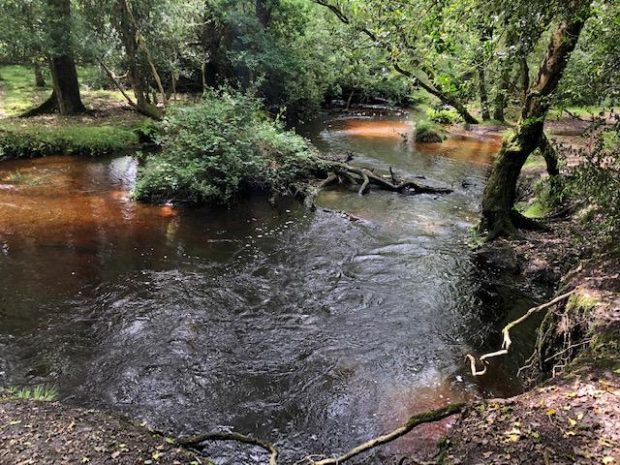
The English countryside is so gentle. Because New Forest is not enclosed, you can see cows and horses wandering unhindered. I can’t tell you what a difference it makes to me to be in Nature when there are no biting insects, no poisonous snakes, and the weather is cool. I walked and walked, praying my prayer rope, talking to Jesus Christ, to the Mother of God, to St. Benedict, and to St. Genevieve. I was getting out of my head, and that was a good place to be. When I passed this flower growing wild on the side of the road, I thought it like an exaltation of church bells, proclaiming the glory of their Maker.

So I walked, and I walked. I finally made my way back into the village, where my return was preceded, appropriately, by donkeys. Like I told you, farm animals have the run of the New Forest:

I made my way to the Forester’s Arms, where I had a pint and a chicken pot pie:
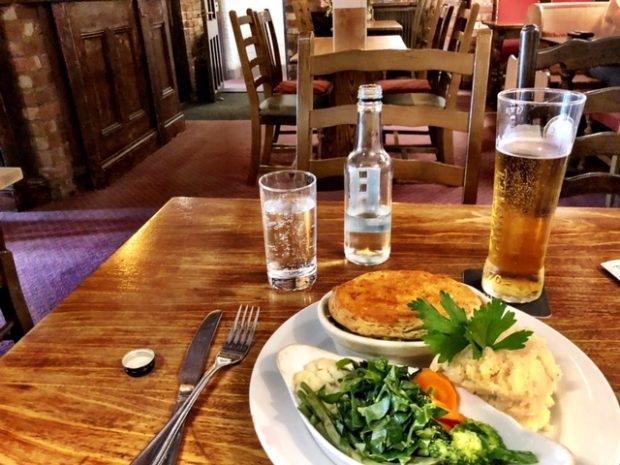
Matt came rolling in after a long ride, worn out. A boy used to riding on the flat roads of East Baton Rouge Parish was not ready for the English hills. He had a pint, referred briefly to New Forest reptiles and Gussie Fink-Nottle, and then we caught the train back to Winchester. We walked from the station back to the cathedral to see Julie and the others before catching the bus back to the hamlet where we are staying. Here is Self outside the cathedral late this afternoon:

Just now, Julie and the kids came in from Winchester, glowing. She had no idea that Evensong was going to feature Tavener’s music. Turns out that tonight is the beginning of the Tavener festival, and Lady Tavener, the composer’s widow, came for the evening service. Julie said the kids were amazed to hear Orthodox vesperal prayers. Of course she and the children crossed themselves Orthodox-style throughout. She said they kept exchange glances of shared Orthodox delight with Lady Tavener, who of course is also Orthodox. But they did not get to meet.
And yes, Julie visited Jane Austen’s grave. Look how beautiful this epitaph is:
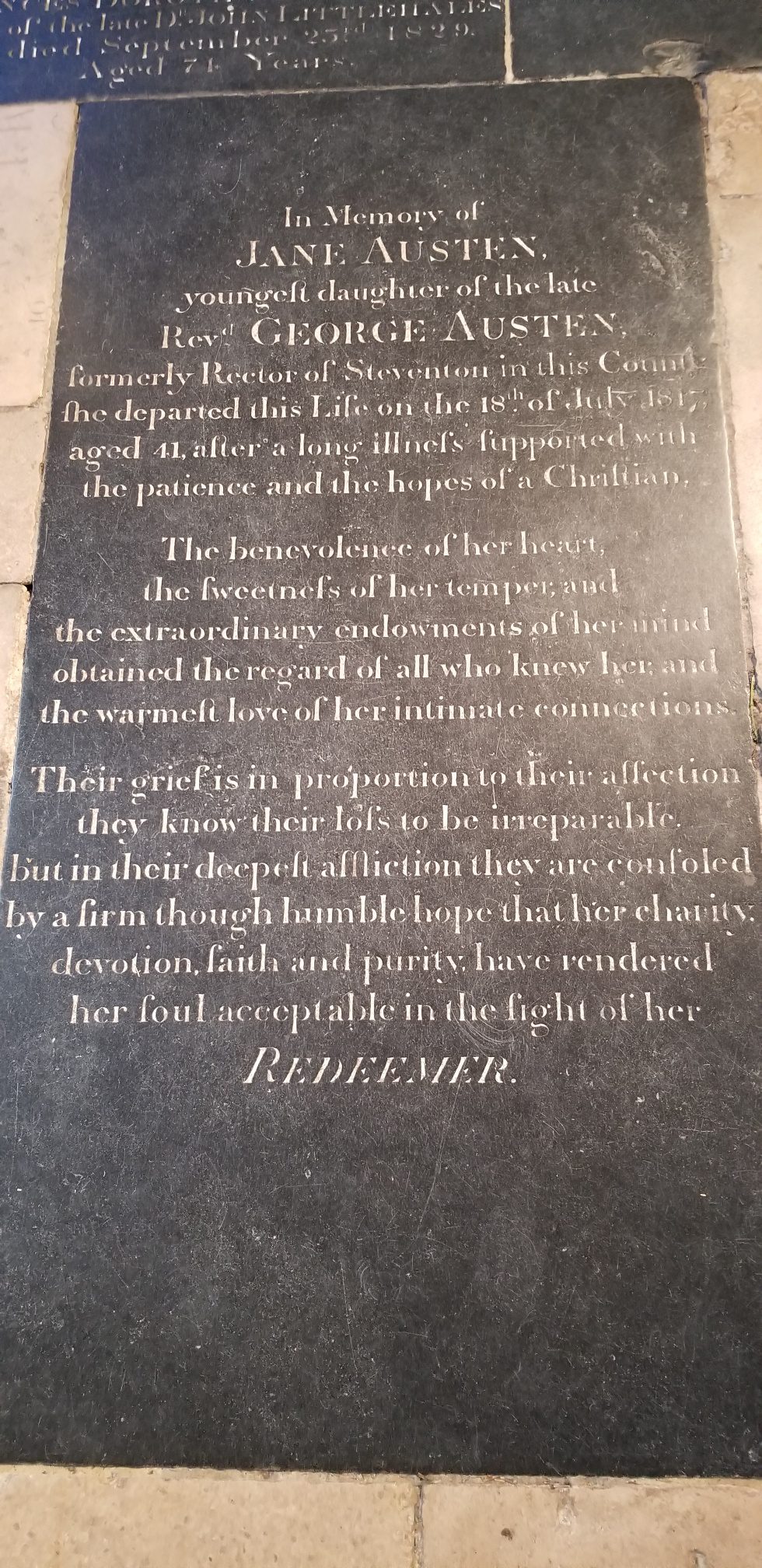
“What’s missing from this?” asked Julie. I dunno, said I.
“The things she wrote,” said Julie, who explained that years after Austen’s death, it occurred to someone at the cathedral that all these people coming to visit her grave must mean that she was a person of merit. And so they began to commemorate her as an author.
Julie and the kids visited Winchester College. Thomas Ken, an 18th century Anglican bishop who is considered one of the father’s of modern English hymnody, had once been a student there. Before Thomas Ken made his mark on the world, he made his mark on the wall of his college:
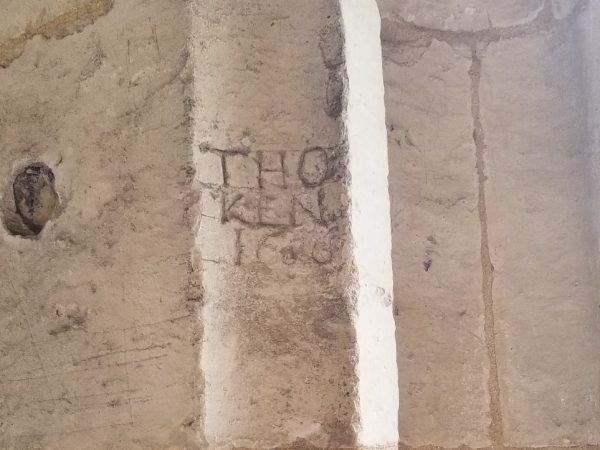
We went tonight to a local beer festival out in a field. Look at these hearty sausage grillers:

I had their Trafalgar sausage on a bun. I can’t remember what was in the sausage, which they made, but I remember the ingredients list had rum in it, and there was something else that the chalkboard said was intended “to remind the French who won.”
Here’s the Trafalgar, in a memorable View From Your Table, at the festival:

It’s 10:35 pm, and it’s finally dark. And that was my day. Good night from England.
UPDATE: Forgot to tell you that one of the local beers I tried was called Pressed Rat And Warthog, because if you’re given the chance to taste a beer like that, why would you not? The name, by the way, is from a Cream song, as I just learned when I googled it. For the kind of people who love beers named Pressed Rat And Warthog, this is the kind of beer they like.
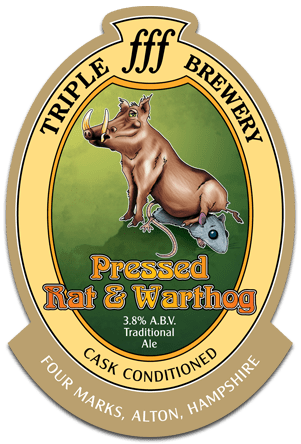
Subscribe for as little as $5/mo to start commenting on Rod’s blog.